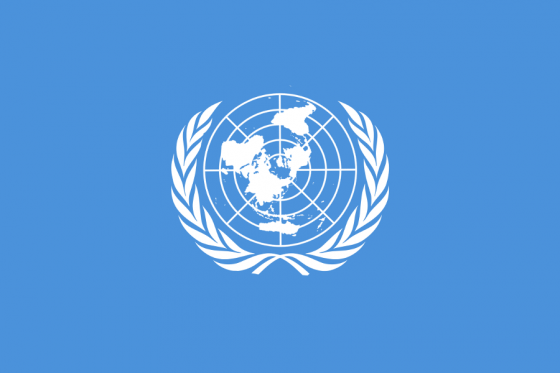BY LETTER
United Nations (Earth)
History > 0030 to 0900 AT: Solsys Era > 030 to 130 AT: The Information Age
History > 0030 to 0900 AT: Solsys Era > 130 to 400 AT: The Interplanetary Age
History > -7000 to 30 AT: Pre-Spaceflight Old Earth > 270 BT to 30 AT: The Industrial Age
Culture and Society > Cultural Factors > Groups and Organizations
History > 0030 to 0900 AT: Solsys Era > 130 to 400 AT: The Interplanetary Age
History > -7000 to 30 AT: Pre-Spaceflight Old Earth > 270 BT to 30 AT: The Industrial Age
Culture and Society > Cultural Factors > Groups and Organizations
 Image from Steve Bowers | |
| Final UN Flag (124 AT) | |
The United Nations was a large and important intergovernmental organization on Old Earth. Despite current common misconceptions, the UN was never a single planetary government or even a true world federation. Instead, it was composed of nearly all sovereign nation-states then existing, at one point reaching over 200 members. Although much about the inner workings of the UN are lost to history, it is understood that each nation had a single vote in the General Assembly, the main deliberative body, while more important powers also held seats on the Security Council that dealt with military matters.
History
Following the destruction of the Second World War, the victorious nations agreed to establish the UN to help preserve the peace. Headquartered in New York City in North America, the UN quickly expanded, creating a host of organizations dealing with matters ranging from interstate conflict, to political instability, to disaster relief and climate change. Over the years, the UN's influence would wax and wane depending on the geopolitical situation but overall grow as the countries of the world became ever more interdependent. In the mid twenty-first century, the UN became the de facto ruler of Antarctica by way of the United Nations Organization for Regulating Colonization of Antarctica (UNORCA).As global economic and political influence changed, so did the United Nations. Emerging powers from the newly developed world such as Brazil, India, and Indonesia were granted seats on the Security Council while France and Britain's positions were consolidated into a single seat for the European Federation. In the early 2100s CE the UN, in conjunction with the South Asian Association for Regional Cooperation (SAARC), enclosed many of the Maldivian Islands inside domes to protect them from rising sea levels. However, efforts such as this would be the exception, and the Earth continued to be plagued by the effects of global warming. Regarding genetic modification, the UN was initially conservative and tried to enforce regulations as seen by the embargo of Sargassa for ape provolution research during the late second and early third centuries AT. This proved increasingly difficult and many operations were moved off-world beyond the effective reach of the UN.
Despite some success on Earth, the UN proved unable to exert meaningful influence in space. Most new polities and corporations in orbit and on Luna were either ineligible or unwilling to abide by UN oversight. One of the few successes was mediating a dispute on Ceres in the 190s AT by creating an administrative center, eventually known as Ceres City, for the four separate colonies then existing. The UN served as a frustrated observer on the Inner Council, an organization created in 216 AT (2185 CE) that quickly became the main forum for mitigating major disputes from Sol to the asteroid belt. This marked the start of the UN's slow slide into terminal decline. On Earth, new competitors emerged such as the South Asian Compact (SAC) that many viewed as a more effective organization. In 252 AT (2221 CE), UNORCA was officially abolished and replaced by the Antarctic Free States. Later in the 23rd century, the Cislunar Alliance would all but replace the UN in matters regarding space. In 334 AT (2303 CE), the UN was finally dissolved, and superseded by the Council of Earth.
Legacy
The UN's impact on Terragen society should not be underestimated. While often derided then and now as bureaucratic and inefficient, it is important to remember that there were no global wars on Earth while the UN existed. Indeed until the reign of GAIA, the UN oversaw the least violent period in Earth's long and storied history, the so called 'Long Peace.' The Federation of Sophonts would borrow freely from the UN and memetic traces can be seen in many First Fed documents and organizations. After the First Federation was dissolved, the Second Federation and later the Solsys Organisation were established using many of the same methods and protocols established by the UN long before.Even in the current era, several polities style themselves as the 'United Nations of' (i.e. the United Nations of New Java) or label their militaries 'Peace Keepers.' Tellingly, UN headquarters on Manhattan Island is also one of the sites preserved by GAIA on Earth with only a few lucky visitors allowed each year.
Related Articles
Appears in Topics
| 030 to 130 AT: The Information Age | 130 to 400 AT: The Interplanetary Age | 270 BT to 30 AT: The Industrial Age |
| Groups and Organizations |
Development Notes
Text by MacGregor
Initially published on 21 June 2017.
Initially published on 21 June 2017.






